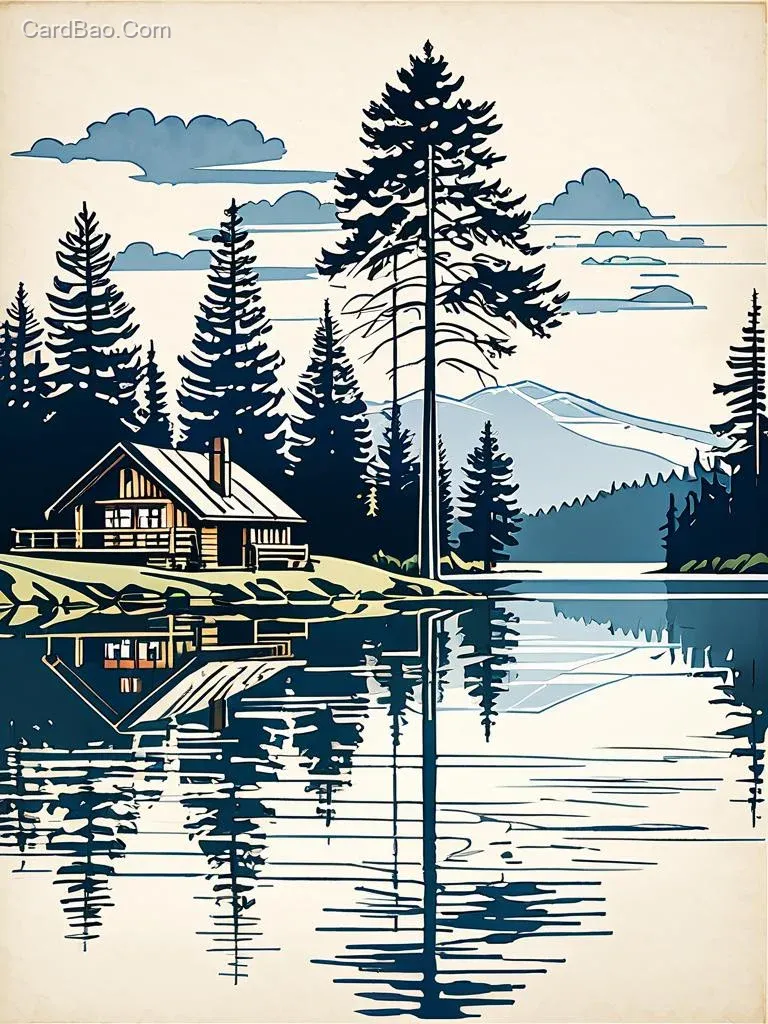
Lakeside Meditation
湖畔静思
English Prompt:
The Lake and Forest Scenery of Mecklenburg (Hand-drawn Pen Illustration)
1. Overall Composition: Use a mid-range composition with the lake positioned at the center of the image, surrounded by forests. Small wooden cabins are artfully distributed along the lake's edge and at the forest entrances, leaving space above to depict the sky, creating an open and harmonious visual effect.
2. Lake Rendering: Outline the lake with smooth, gentle curves to capture its natural, winding form. Use very light and sparse lines within the lake to depict the water surface, varying the density of lines to convey light and shadow reflections. In areas reflecting the sky and clouds, use even lighter strokes to softly suggest their shapes. The lake's edges should feature short, fragmented lines to illustrate aquatic plants and rocks, adding realism.
3. Forest Representation: The forest consists of dense trees. Use lines of varying lengths and directions to draw the trunks, showcasing the varying heights and postures of the trees. For the tree canopies, employ dense short lines and small dots to depict lush foliage. The reflections of trees near the lake should be rendered with soft, blurred lines to blend with the water's surface. Different tree species should be distinguished by line density and shape—for example, use slender lines for pine needles and thicker, curved lines for broad oak leaves.
4. Wooden Cabins: Construct the cabins' outlines with simple geometric shapes, then add detailed lines to portray wooden textures, such as plank joints and door/window edges. Use thicker lines for shadowed areas to create a three-dimensional effect. Roof tiles should be drawn with short, neat, parallel lines. Surround the cabins with loose, casual lines to depict flowers, grass, or wooden fences, adding a sense of life.
5. Sky Depiction: The sky should feature sparse horizontal lines and faint dots to suggest clouds. Near the lake's reflection, the cloud lines should be even lighter and more dispersed. Use negative space to highlight bright areas of the sky, and lightly sketch a few birds with faint lines in the blank spaces to enhance the scene's liveliness.
6. Line Texture and Shadow Treatment: Maintain the pen's characteristic smooth and crisp lines throughout the illustration, avoiding excessive dragging. Use variations in line density and weight to depict shadows and dimensionality—for example, densely packed, heavier lines for shaded areas of the forest and lighter, sparser lines for illuminated sections. Along the lake's shore, shadows should be rendered with slightly heavier lines, while underwater shadows should be faint and diffused.
中文Prompt:
梅克伦堡的湖林景致(纯手绘钢笔插画)
1. 画面整体布局:采用中景构图,将湖泊置于画面中心位置,让森林环绕四周,小木屋巧妙分布在湖泊边缘与森林入口处,留出上方部分空间描绘天空,营造开阔又和谐的画面感。
2. 湖泊绘制:用流畅且轻柔的曲线勾勒湖泊轮廓,展现其蜿蜒自然之态。湖泊内部用极淡且稀疏的线条表现水面,通过疏密变化体现水面光影,在倒映蓝天白云处,用更浅淡的线条轻轻带出形状。湖泊边缘用短而碎的线条描绘水草、石头等,增加真实感。
3. 森林表现:森林以茂密的树木组成,用不同长度和方向的线条绘制树干,体现树木的高低错落与姿态各异。树冠部分用密集的短线条和小圈点表现树叶的繁茂,靠近湖泊的树木,在水中的倒影用轻柔且模糊的线条处理,与水面效果相融合。不同树种用线条疏密、形状差异区分,比如松树用细长线条表现针叶,橡树用较粗且弯曲的线条表现宽大叶片。
4. 小木屋绘制:小木屋用简洁的几何形状搭建轮廓,再用细腻线条刻画木质纹理,如木板的拼接处、门窗的边缘等。用较粗线条表现木屋的阴影部分,体现立体感,屋顶的瓦片用短小整齐的线条排列绘制。小木屋周围用随意的线条描绘一些花草、木栅栏,增添生活气息。
5. 天空描绘:天空部分用稀疏的横线和淡点表现云层,在靠近湖泊倒影处,云层线条更淡更疏。用留白手法展现天空明亮区域,在空白处轻轻用淡线条勾勒出几只飞鸟,增强画面生动感。
6. 线条质感与阴影处理:整幅画线条要保持钢笔特有的流畅与干脆,避免过于拖沓。通过线条疏密、轻重来表现物体的阴影和立体感,比如森林中树木背光处线条密集且重,受光处线条稀疏且轻。湖泊的阴影在岸边用稍重线条表现,水中阴影则用淡而虚的线条处理。
Resolution: 768×1024